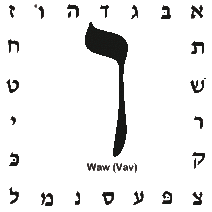
The Hebrew Conjunction
In English the conjunction "and" is always written separately; in Hebrew the conjunction "and" (vav) is prefixed to the following word.
As we learned in other lessons, words in Hebrew will undergo vocal changes when prefixes are attached. The same happens with the "vav conjunction" as well. Lets take a look at the rules governing the vav conjunction:
Rule #1
Most often the vav conjunction appears as vav plus sheva. This vav-sheva combination will occur before consonants pointed with a full vowel.
Rule #2
Before "labials" (bet, mem and pe — those consonants formed by the lips) the vav conjunction is written as a sureq.
Rule #3
Before yod and sheva a contraction happens and we are left with vav-hireq-yod.
Rule #4
Before a compound sheva the vav conjunction takes the corresponding short vowel of the compound.
Rule #5
Before monosyllabic words or words with accents on the first syllable, the vav conjunction is usually written as vav-qames.
Mnemonics to Remember the Rules for the Vav Conjunction
Rule#1: The Vav Conjunction Sheva and Shakes!
Simply memorize that the basic pointing of the vav conjunction is a sheva.
Rule #2: Labials "sure wreck" (sureq) the Vav Conjunction!
You know that the basic rule for the vav conjunction is to point them with a simple sheva. When you come across a "labial" (bet, mem or pe) just remember that the labials sure wreck (sureq instead of vav-sheva) the vav conjunction!
Rule #3: Yo! Slide on over!
This is another easy to remember rule. Simply visualize that when you encounter a yod-sheva that the yod "slides" next to the vav and knocks out one of the "dots" of the sheva to form the vav-hireq-yod.
Rule #4: Compound sheva sheva on the wall, who's the prettiest of them all?
When you encounter a compound sheva, simply remember that the sheva (which looks similar to a wall mirror) reflects back the half-vowel under the vav conjunction.
Rule #5: Single Syllable's are Tillable with Qames!
When you find a single syllable word (monosyllabic) or words that carry the accent on first syllable, just remember "single syllables are tillable." The qames looks like a shovel — a tool you use to "till" the ground under the vav forming a vav-qames conjunction.
More Biblical Hebrew Memory Helps!
I hope this article on learning the rules for the Vav Conjunction in Hebrew has helped you! For more powerful memory helps in learning Biblical Hebrew grammar, vocabulary and Hebrew paradigms be sure to visit Biblical Hebrew Made Easy! Or visit my author homepage, Boost Your Memory! While you are there, make sure to sign up for our newsletter for special discounts and announcements!
In English the conjunction "and" is always written separately; in Hebrew the conjunction "and" (vav) is prefixed to the following word.
As we learned in other lessons, words in Hebrew will undergo vocal changes when prefixes are attached. The same happens with the "vav conjunction" as well. Lets take a look at the rules governing the vav conjunction:
Rule #1
Most often the vav conjunction appears as vav plus sheva. This vav-sheva combination will occur before consonants pointed with a full vowel.
Rule #2
Before "labials" (bet, mem and pe — those consonants formed by the lips) the vav conjunction is written as a sureq.
Rule #3
Before yod and sheva a contraction happens and we are left with vav-hireq-yod.
Rule #4
Before a compound sheva the vav conjunction takes the corresponding short vowel of the compound.
Rule #5
Before monosyllabic words or words with accents on the first syllable, the vav conjunction is usually written as vav-qames.
Mnemonics to Remember the Rules for the Vav Conjunction
Rule#1: The Vav Conjunction Sheva and Shakes!
Simply memorize that the basic pointing of the vav conjunction is a sheva.
Rule #2: Labials "sure wreck" (sureq) the Vav Conjunction!
You know that the basic rule for the vav conjunction is to point them with a simple sheva. When you come across a "labial" (bet, mem or pe) just remember that the labials sure wreck (sureq instead of vav-sheva) the vav conjunction!
Rule #3: Yo! Slide on over!
This is another easy to remember rule. Simply visualize that when you encounter a yod-sheva that the yod "slides" next to the vav and knocks out one of the "dots" of the sheva to form the vav-hireq-yod.
Rule #4: Compound sheva sheva on the wall, who's the prettiest of them all?
When you encounter a compound sheva, simply remember that the sheva (which looks similar to a wall mirror) reflects back the half-vowel under the vav conjunction.
Rule #5: Single Syllable's are Tillable with Qames!
When you find a single syllable word (monosyllabic) or words that carry the accent on first syllable, just remember "single syllables are tillable." The qames looks like a shovel — a tool you use to "till" the ground under the vav forming a vav-qames conjunction.
More Biblical Hebrew Memory Helps!
I hope this article on learning the rules for the Vav Conjunction in Hebrew has helped you! For more powerful memory helps in learning Biblical Hebrew grammar, vocabulary and Hebrew paradigms be sure to visit Biblical Hebrew Made Easy! Or visit my author homepage, Boost Your Memory! While you are there, make sure to sign up for our newsletter for special discounts and announcements!
 RSS Feed
RSS Feed
